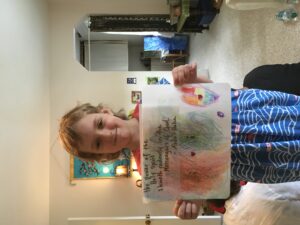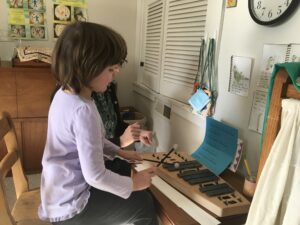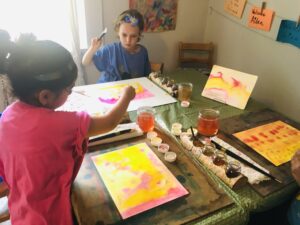Slide Show of Refuge Class | Refuge: Seeds

Our on going research of the Refuge Research Collaborative examines the covenantal relationship each individual has with his or her Creator. Research has indicated, primarily the work of Dr. Sophia Cavalletti, that this relationship changes in aspect by age.*
The Refuge Research Collaborative’s goal is to examine this intensely personal relationship and how it develops over time. The research is done in the context of the Baha’i writings.
Our focus is on the very foundation of moral development which is the knowledge and love of God through His Holy Word.
“Having created the world and all that liveth and moveth therein, He…chose to confer upon man the unique distinction and capacity to know Him and to love Him…a capacity that must needs be regarded as the generating impulse and the primary purpose underlying the whole creation…” Baha’u’llah
We meditate, or think deeply, on the Word of God.
To help develop this deeper relationship with the Word of God, every class has a guiding quotation for the child to wonder about.
Stories and Biblical parables relating to the quotation help us think further.

We also offer physical materials which extend the meditation.
The children are free to use these materials as many times as they need to.
A natural outcome of this meditation is prayer.
We do not tell the children our interpretation of the meaning of the writing.
That is for the child to discover on their own through their work.
This way, any discoveries they make about the writing are truly theirs.
It is their relationship with the Creator.
Each time they use these spiritually based materials new insights can come to light.
This is the work of building a conscious knowledge of God.
Research indicates children (3-5) are at a period of sensitivity for protection and love.
In our class we found that the children respond very readily to the metaphor of the Manifestation of God as being like a Good Shepherd.
Baha’u’llah and Abdu’-Baha tell us in their writings that a Manifestation of God is like a shepherd guiding and protecting his flock.
Preparation for meditation – Practical Life activities
In our 4-6 year old class we have found that having practical life activities which children can work on before meditating, helps them to settle and focus during the meditation. Activities such as cutting paper, stringing beads, pouring water into clay land formations in a dish, polishing silver and flower arranging all have their place in assisting the child to increasingly control their will and further develop fine motor skills.
Our meditation process:
The adult and the child are in The Word together.
They are wondering about the meaning of the quotation together.
To do this the adult must stop talking and listen to the child and to their own inner voice.
The adult must trust the power of The Word to do the work.
Furthermore, the child needs time to spend with the quotation they are attracted to.
In the Refuge we extend our meditations through:

Music: Music plays an important role in the Refuge. Sacred writings and prayers sung really seem to touch the heart. We both sing and chant the sacred verses.
In the 4-6 class we’ve been exploring ways the children can express themselves musically. We have been chanting our verses to a beat using our hands or drums. We have also been playing the glockenspiel using a pentatonic scale so that no matter what note the child plays they sound good together. We have found that when we offer only a few notes at a time, 3 bars on the instrument in the pentatonic scale, they are able to come up with simple, yet very satisfying tunes. We also play musical games at the beginning of class, which gets their bodies moving which assists in greater focus and concentration later in the class.
Artistic Response to Meditations:
We will ask the child a question regarding the meditation they thought about that day, and then ask them to make a drawing using colored pencils or block crayons. For example, after a meditation on the soul, “You are as polished mirrors reflecting pure light” -Abdu’l-Baha, we asked the children, “If you could see your soul what would it look like? Draw a picture. Afterwards we ask the children to tell us about their drawing. The children all love to draw. Looking at their drawings and hearing their descriptions is like a window into their spiritual thoughts. Their responses help us to know something about them; their questions, hopes, and fears. They give an indication of what writings or spiritual concept to focus on next.
Block crayons in particular are enjoyable because they enable the child to focus more on broad shapes instead of lines. Over time this helps them in their ability to draw. Block crayons are made of beeswax and can be combined to make new colors. For example, the entire rainbow of colors can be created just using red yellow and blue. Block crayons also strengthen the fingers thus assisting in greater fine motor control.
We prefer colored pencils over markers because the colors are more subtle and can be combined together to make new shades.

Wet-on-wet watercolor painting has its own special place in the Refuge and is taught with a spiritual reverence. Painting is done, as much as possible, without talking, and with peaceful music in the background. Young children are process, not product, oriented artists. Painting with watercolors can be an experience which helps the child to slow down and continue their spiritual thoughts.The facilitator may say a few words about the writing and will model painting to the children. He or she then leaves the children to their own spiritual thoughts as they become absorbed in the colors flowing onto the paper. Children need that time with the inner Teacher to make their own spiritual discoveries.Even though young children care more about the process, than the end product, the end result of watercolor paintings is always beautiful. Children are attracted and moved by beauty so watercoloring is a perfect catalyst for spiritual meditation.
As facilitators of the Refuge, we tell the children that they can draw or paint about anything they want at home but here in the Refuge they have a special time set aside for them to paint and draw what they would like to express to God. It is a special gift to have this time to do that. Thus we encourage them to set the outside world aside, and focus more on matters of the heart.

Science:
We investigate reality based on the themes we are meditating on by learning new things about the natural world. We use science experiments and keen observation through the lens of awe and wonder for the many gifts God has given us. These themes are rich in spiritual metaphors from the sacred writings. Things we have explored in the past are based on the kingdoms of God: mineral, plant, animal, human and the Kingdom of the Manifestation of God. We explore properties of the Earth beneath our feet, gems, minerals, magnets, land forms, and how the earth was formed. We observe the growth of plants, trees and the hidden world of seeds and leaven. We discover aspects of ocean life, pearls and how they are created. The animal kingdom is looked at with a focus on animal senses, the cooperative life of bees and protective nest building of birds. When meditating on the Kingdom of the Manifestation, an investigation into the life of shepherds, the sheep they watch over, creative uses for wool, the many gifts from our sun, properties of light, color and reflections are all especially important.
Sacred Geography:
We study where the Holy Manifestations were born, lived and died.
Abraham, Krishna, Zoroaster, Moses, Buddha, Jesus, and Muhammad, the Bab and Baha’u’llah
4-6 year olds wanted to know:
Are the Manifestations real or imaginary?
Did they walk upon this earth?
Baha’i History:
Children learn some basic Baha’i history in the Refuge, primarily through inspiring stories about the Baha’u’llah’s life. We once asked a child, “Why do you think it’s important to know these stories?” The child wisely said, “Because they can help you become closer to God.” We are always amazed at how young children can get right to the most essential point, the very heart, of a matter. When we learn these stories, we understand that nothing is more important than our relationship with the Creator who loves us and sent Manifestations to guide and protect us. Early stories cover Baha’u’llah’s time in Akka, Mazirih, the Ridvan Garden and Bahji.
Some things we have learned from our research:
1. Our new meditation process caused us to slow down. To avoid using a lot of materials that seemed immediately enticing, but in fact, distracted the children from listening to that inner voice that is instrumental in developing their relationship with God.
2. In this meditation process we found that the children are even more closely connected and engaged when materials are simple and natural and when we explore a theme multiple times, in multiple ways.
3. We shifted from feeding facts and information to the students to encouraging them to explore their own understanding, of the meaning of God’s Holy Words, and themes that attract their hearts.
4. What surprised us is that children of this age are eager to discuss with one another their understanding of the sacred writings.
5. Kids really want to think about the Word of God. We thought they would be bored, or wouldn’t focus, and need to run around, but what we found over time is that the children are able to focus more.
6. They have an inner focus beyond what we expected for this age. We feel this is because we are focusing on the essentials of the teachings which are most important to them.
7. We encourage the children to pray spontaneously from the heart because memorized prayers, in earlier classes, were said fast and without much reverence. Through this process their prayers became genuine.
*Sofia Cavalletti, Italian Hebrew scholar, and Gianna Gobbi, Montessori educator, used Montessori’s vision of the developmental planes and applied them more specifically to the spiritual development of the child. With 50 years of cross cultural research, they pinpointed spiritual sensitive periods in the development of the child. They called these sensitive period, “vital exigencies”. Vital exigencies are similar to sensitive periods but occur deeper in the human psyche. They are deep vital needs of the human being and they change in emphasis according to the developmental stages of the child. However, even when it is no longer a developmental focus, the need for the vital exigency is always there. According to Cavalletti, ”for catechesis (religious training) to be a living event for the child, the catechist (adult guide) should know the child’s exigencies and the aspect of God that most corresponds to him or her.” (Sofia Cavalletti, Religious Potential of the Child p.169) !
Recommended reading:
Listening to God with Children by Gianna Gobbi
The author personally worked as an apprentice with Maria Montessori. In collaboration with Sofia Cavalletti, a biblical scholar, Gianna played a primary role in applying the principles of the Montessori method to the religious formation of children, now embodied in the Catechesis of the Good Shepherd.
The Religious Potential of the Child
The Religious Potential of the Child 6 to 12 years old by Sofia Cavalletti, Founder of the Catechesis of the Good Shepherd.
Cavalletti and Gobbi collaborated for more than 50 years, listening to and observing children in the context of a prepared religious environment called an atrium, basing their approach on the principles of education developed by Maria Montessori.